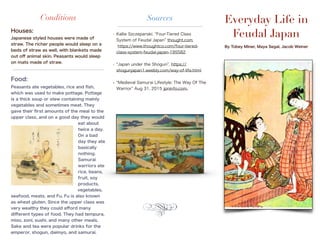Museum brochure
- 1. Sources _______________________________________________ âĒ Kallie Szczepanski, Four-Tiered Class System of Feudal Japan thought.com, https://www.thoughtco.com/four-tiered- class-system-feudal-japan-195582 âĒ Japan under the Shogun , https:// shogunjapan1.weebly.com/way-of-life.html âĒ Medieval Samurai Lifestyle: The Way Of The Warrior Aug 31, 2015 jpninfo.com. âĻ Conditions Houses: Japanese styled houses were made of straw. The richer people would sleep on a beds of straw as well, with blankets made out oïŽ animal skin. Peasants would sleep on mats made of straw. __________________________________________________ Food: Peasants ate vegetables, rice and ïŽsh, which was used to make pottage. Pottage is a thick soup or stew containing mainly vegetables and sometimes meat. They gave their ïŽrst amounts of the meal to the upper class, and on a good day they would eat about twice a day. On a bad day they ate basically nothing. Samurai warriors ate rice, beans, fruit, soy products, vegetables, seafood, meats, and Fu. Fu is also known as wheat gluten. Since the upper class was very wealthy they could aïŽord many diïŽerent types of food. They had tempura, miso, zoni, sushi, and many other meals. Sake and tea were popular drinks for the emperor, shogun, daimyo, and samurai. Everyday Life in Feudal Japan By Tobey Miner, Maya Segal, Jacob Weiner
- 2. Different Classes _______________________________________________________ Feudal Japanese society was dominated by the samurai warrior class. Although they made up only about 10% of the population, samurai and their daimyo lords wielded enormous power. Their workdays depended on the diïŽerent classes. The Emperor and the ïŽgureheads would not do very much they were considered to be inïŽuences, but did not have very much say on how to run the country. The Warrior class were the real leaders of Japan and did most of the work running the country. The farmers and ïŽsherman provided food for Japan and would spend their days harvesting and ïŽshing. The craftsmen would build weapons for the soldiers. Work Days _______________________________________________ Their workdays depended on the diïŽerent classes. The Emperor and the ïŽgureheads would not do very much they were considered to be inïŽuences but did not have very much say on how to run the country. The Warrior class were the real leaders of Japan and did most of the work running the country. The farmers and ïŽsherman provided food for Japan and would spend their days harvesting and ïŽshing. The craftsmen would build weapons for the soldiers. Animals ________________________________________________ The wildlife in feudal Japan includes many natural habitats. The islands of Japan stretch a long distance from north to south and cover a wide range of climatic zones. This results in a high diversity of wildlife, despite Japan's isolation from the mainland of Asia. In the north of the country, there are many subarctic species which have colonized Japan from the north. In the south there are south-east Asian species, typical of tropical regions. Between these areas lies the temperate zone which shares many species with China and Korea. Japan also has many endemic species that are found nowhere else. Daimyo Farmers & Peasants Artisans & Craftsmen Merchants


